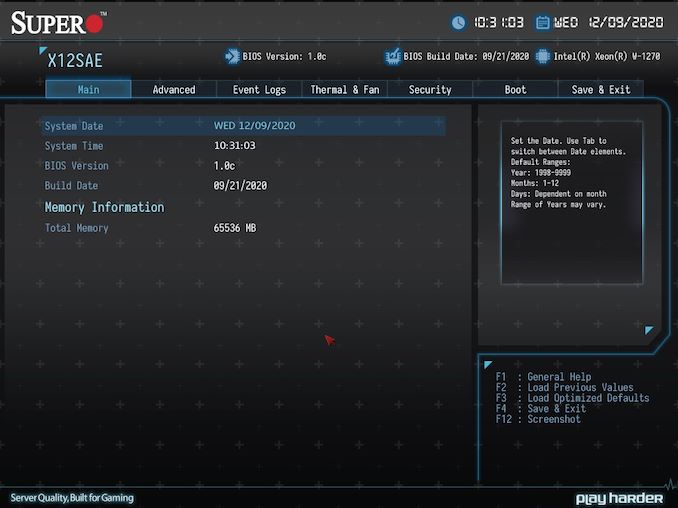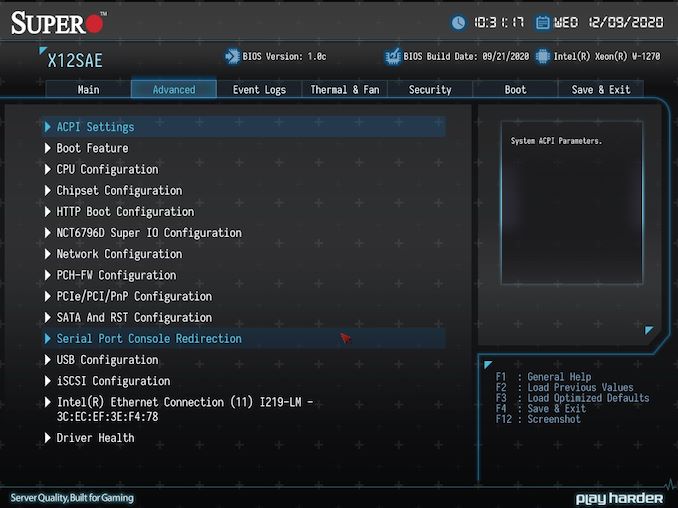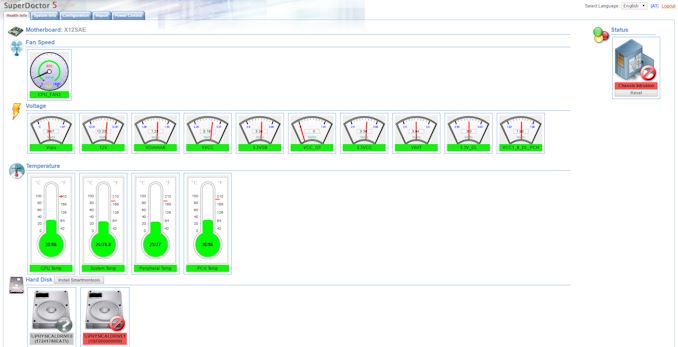Supermicro X12SAE W480 Motherboard Review: For Xeon W-1200 Workstations
by Gavin Bonshor on December 11, 2020 9:30 AM ESTBIOS
The Supermicro X12SAE is using its more consumer-friendly SuperO firmware and not the Aptio based firmware. The SuperO UEFI firmware is using a black and grey user interface, with plusses that resemble keyboard switches throughout the background. It is using a mixture of blue and turquoise text, with deeper royal blue highlighting to signify which option is currently selected. In the bottom right hand corner of the GUI, is a key index that includes a help menu that can be accessed by pressing F1, with simple and easy ways to revert back to default settings by pressing F2.
The initial screen upon entering the BIOS is a very simple layout with a list of basic information. This includes the system date, time, the firmware version the board has installed on the 256 MB chip, as well as the date the BIOS build was released. Underneath this is the memory information which is a little archaic, and only displays the capacity as opposed to the current settings.
Along the top is a list of the menus which consists board's advanced settings, event logs, thermal and fan, the security options, the boot menu, and the typical save and exit menu. The advanced menu incorporates all of the CPU and chipset options, as the Supermicro X12SAE doesn't support overclocking. This also includes all the current W480 models, as the supported Comet Lake Xeon W-1200 processor cannot be overclocked. With that in mind, the advanced section includes submenus which include chipset configuration, enabling and disabling CPU specific features such as Hyper-Threading, AES, and Intel's SpeedStep functions.
The board's memory and integrated graphics settings can be found under the System Agent submenu within the advanced section. The same way as the W480 chipset doesn't support CPU overclocking, memory overclocking isn't supported and the maximum in terms of speeds is DDR4-2933. This also means users cannot tweak the memory latencies and is reliant upon the SPD list of the installed memory. Users can also slightly tweak the integrated GPU, with limited options including enabling or disabling the Turbo GT frequency as well as setting the frequency to the default max frequency for optimal performance.
The Supermicro X12SAE's firmware is geared up more towards professional use and it makes the most out of the Intel W480 feature set. This includes basic fan control which is unified across all of the board's five 4-pin headers, with no options to individually set them. It's either all at full-speed or none for example. The firmware also has settings for setting up the system to boot from HTTP and allows log in across a network, with support for its SuperDoctor 5 utility. Overall the firmware is easy to navigate, is responsive with a USB keyboard and mouse, and includes all the functionality within the BIOS to support its hardware.
Software
As Supermicro hasn't included any disc or USB media with software and drivers within the accessories, users will need to download the latest .iso file directly from the official product page. Included in the .iso file is a selection of core drivers including the chipset, audio, Intel Pro networking drivers, as well as the SuperDoctor 5 utility.
The Supermicro X12SAE is designed for workstation use and such is using its SuperDoctor 5 software which it universally uses across its workstation and server range. One of its main attributes is that it allows for instantaneous real-time monitoring of key components and vital statistics such as temperature and voltages. Users can also connect to SuperDoctor5 remotely and use features such as the event log, as well as flash the board's firmware. The lack of an IPMI controller does limit its functionality a little, especially if a system is left to its own devices. This means it's not constantly monitoring, although this is primarily more useful for servers, whereas a workstation is likely to be accessed physically.

























55 Comments
View All Comments
SSNSeawolf - Friday, December 11, 2020 - link
RoCE/iWARP link is a good example. Even a small software-defined storage setup will easily saturate a pair of 50GbE links. 100/200/400 GbE needs PCIe 4 as a practical requirement.ae00711 - Saturday, December 12, 2020 - link
do be serious - that kind of kit isn't installed in single socket /workstations/. That end of the spectrum is for dual (or more) socket.SSNSeawolf - Saturday, December 12, 2020 - link
That's a common use case for this stuff. RDMA cards are $300-400. I'm not sure why you think RDMA is so fancy to need dual or quad socket. Run it on an i5 for all it cares.Jorgp2 - Sunday, December 13, 2020 - link
The fuck would you stick a 400GbE card in this board?Slash3 - Friday, December 11, 2020 - link
The networking issue may be a result of a faulty 1V/V2 revision i225-V LAN controller chip. When plugged into a switch or router at 2.5Gbit, they have a malformed Inter-Packet Gap that can cause dropout, heavily reduced bandwidth or atrocious latency. It was covered briefly at the time and has since fallen a bit by the wayside, but wouldn't surprise me if it was the root cause.https://www.techpowerup.com/img/immgrcH3WvH9P6o0.j...
Mitigation includes an updated driver or to set it manually to 1Gbit.
As for the atrocious memory support and other problems, those are all on Supermicro.
ae00711 - Saturday, December 12, 2020 - link
agreed.the one time I needed support from supermicro, un-f88king-believable - worst I've seen from a tech company. I do have a lot of SM mobos (workstation and server), the products are decent for the most part, but you're f88ked if you need support. I try to buy intel and tyan now-a-days.
RU482 - Friday, December 11, 2020 - link
With regard to ECC memory...if I have this X12SAE motherboard with a Xeon W-1290E CPU, do I HAVE to use ECC UDIMMS? or will the system operate with more common non-ECC UDIMMS?this would ignore the "Why don't you just use a core i9 instead of W-1290E" question
Alsw - Friday, December 11, 2020 - link
Those core counts in the table on page 1 are way off for the most part some copy and paste errors e.g. 1290p is 10 cores, 20 threads. Regarding Intel vs AMD Right now it's tricky in the Workststion space companies want the backup of OEM support only lenovo has broken and started offering threadripper Pro which to be honest isn't that compelling. At the low end most are OK without ECC ram so rysen 5000 would do well against i7/i9 workstations from dell/hp lenovo but as soon as you get to things like FEA, CFD other scientific type workloads then ECC is what users are looking for and not all of them need masses of cores it depends on the solver, problem type etc how well it scalesBut A small change from AMD in properly supporting ECC would make a big difference to making inroads
Maybe they are just less focused on this market as their Radeon pro cards fall ever behind NVIDIA Quadro (I refuse to stop using that name as its just crasy to drop such a string brand!)
DracoDan - Friday, December 11, 2020 - link
Wait... a *PCI* slot?! Like from 1992??? Where did they even find the old-new stock of PCI connectors? Crazy to think that a board that worked in a 486 (albeit a limited subset of 486 systems) can work in this board!Ithaqua - Friday, December 11, 2020 - link
There are a few MB makers that still have PCI / PCI-X / AGP Slots.Not sure about VLBus or ISA (8/16) but who needs to install the original soundblaster card or a CGA video card in a new system?